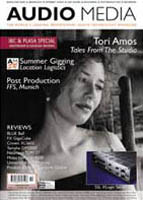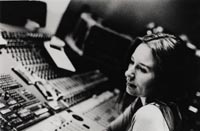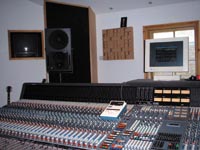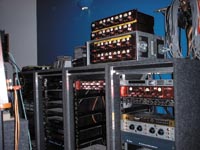|

songs | interviews | photos | tours | boots | press releases | timeline
Audio Media (European edition)
October 2003

Tales from the Studio
American expatriate songstress Tori Amos is something of a suffragette, with an interesting approach to recording her new 'Best Of' album. In an Audio Media exclusive, JONATHAN MILLER ventures into darkest Cornwall to talk Tales of a Librarian: A Tori Amos Collection with its creator, co-mixer Mark Hawley, and mastering maestro Jon Astley.

"I need to represent American history -- from 1990 to 2003, because that's what I write about, as well as the religious implications; and a Western woman's life, and her love, and her losses, and in the end, hopefully, her autonomy. That's what this is about -- the social and the personal, 1990 to 2003; it's a time capsule."
So summates Tori Amos, fluently referencing her forthcoming 'Best Of' album, Tales of a Librarian: A Tori Amos Collection -- not that the oft-used 'Best Of' cliche sits comfortably with the thoughtful, complex, controversial forty-something singer/songwriter, who spent her formative years in North Carolina, musically rebelling against the teachings of her Methodist minister father. "I don't call it a 'Greatest Hits' because to some people that means one thing and to other people it means something else," Amos reasonably reasons. "I mean, Van Gogh really didn't have a 'Greatest Hit' whilst he was alive! So I thought the idea of a 'Best Of' should be the best that we can offer."
In the case of Tales of a Librarian the collective "we" is a small, tightly-knit production collective comprising the increasingly self-determining Amos doubling up in a joint production and performance capacity, more often than not playing alongside drummer Matt Chamberlain and bassist Jon Evans -- the gifted rhythmic backdrop to Amos' stripped down live act of late, and ably assisted by the proven skills of mix engineers Marcel van Limbeek and Mark Hawley, plus mastering maestro Jon Astley.
 Home Is Where The Art Is
Home Is Where The Art Is
Hailing from Northern England, the humble Hawley ultimately got more than he bargained for since successfully auditioning to become Amos' live sound engineer back in 1994 -- he just so happens to be the multi-million-selling recording artist's husband of five years. He describes his ascent up the professional recording ranks: "I started off in studios, and grew to hate working in studios as a jobbing engineer, because up North I was recording fairly ropey acts. It wasn't fun; the gear was dreadful. I'd done a few live gigs for a local PA company, so off I went on tour, and that was my life. Then Marcel and me got offered Tori's tour in '94, and we decided to record it, because it was just her and her piano. We did some B-sides, which were well received, and she said, 'Well, why don't you come and record the next album?' So that got us back in the studio, and once we'd done that album it just made total sense for her and me to build a studio."
With 1996's critically acclaimed Boys for Pele -- partly recorded in an unspecified church in Delgany, County Wicklow, and "a wonderfully damp Georgian house in County Cork, Ireland" -- in the bag, and having tied the knot with his erstwhile employer, Hawley was better positioned to do just that. For Hawley, it transpires, is largely responsible for the capable couple's relocation to a picturesque farmhouse outside of Bude in rural Cornwall, scene of many a happy childhood holiday for the now-creatively contented mix engineer. Adjacent to said farmhouse is a tastefully converted barn, housing an upmarket, expansive Neve console and a brace of attendant recording luxuries that only 12-million albums sales (and rising) can buy.
Martian Engineering is the inspirational private facility's anomalous appellation, although whether this in any way vaguely alludes to its owners being visitors to the Cornish coast goes unrecorded. For her not inconsiderable part in the move towards total studio ownership, Amos cites another forward-thinking artist with planting a home-based recording seed that eventually flowered with more than a little help from Hawley. "A home studio is one thing, but this is not a home studio -- we haven't opened it up to the public as of yet," jests Amos. "I think that talking to Peter Gabriel was one of the reasons that this happened. He told me back in 1995 that I should be working in my own workshop and set up a team of engineers to work with, because a lot of artists cannot guarantee to be working with the same studio team from album to album. He also told me that he felt you could make your first successful album, and your second successful album, based on having something to say, but he said then it really becomes about going to the workshop and composing, working on your skills all the time, because a lot of people that have had one successful record as a songwriter don't ever experience that again."
Much more than a simple 'Best of' collection.
Having heeded Gabriel's wise words, fortunately there would be no such woeful tales on that front for Amos; Tales of a Librarian constitutes the American artist's fifth album to have been recorded, mixed, and mastered at Martian Engineering, having already notched up 12 Top 40 entries on the UK Singles Chart before the close of the Nineties -- including 1997's chart-topping, dancefloor-packing "Professional Widow (It's Got to Be Big)" remix in collaboration with Armand van Helden.
The Politics of Dancing
Having signed to Sony in time for last year's longplaying effort, Scarlet's Walk, Amos was already contractually committed to supplying the Atlantic Recording Corporation with that unspoken 'Greatest Hits' album, and with it a limited number of new recordings. Evidently this got Amos thinking about getting her hands dirty; this was not going to be a straightforward cashing-in compilation exercise, but rather a more creatively substantial offering in celebration of her lengthy Atlantic tenure -- hence her self-imposed opening remit for Tales of a Librarian: A Tori Amos Collection.
Amos' thinking makes for refreshing reading, all the more so when presented in the typically vibrant language that her many supporters have come to expect and respect: "With the people who come to the shows I've seen ten 'Best Ofs' per night of my work -- they've made their own. So why would they need me to take it off the original CDs and just burn them? They can do that for themselves, so why should they pay $15 for that? I thought, 'Would I want to listen to these songs by this woman in this way?' And I said to myself, 'Well, the albums exist if I want to do that.' But I listened to all of them and said, 'If I were to produce them; if I were in the driver's seat, I wouldn't do that.'"
According to Amos, politics played an unhealthy part in determining why some of those original recordings sound so unsatisfactory to her sensitive ears. "With a lot of these records at the time, certain arrangements were not used because somebody at the label thought that it wasn't commercial," she laments. "Yet the arrangements had been approved, and they were beautiful, but there were a lot of cooks in the kitchen. Some things were edited out for wrong reasons -- to try and chase some kind of glorified success, instead of what was good for the music at the time."
 Back to the Future
Back to the Future
Backtracking, husband Hawley picks up the historic recording and remixing trail, travelling several thousand miles in the process. "Originally, we thought, 'Well, there's certain tracks that Marcel [van Limbeek] and myself recorded that we wanted to have a go at remixing, because we thought we could have done better at the time, and then there were always some songs that Tori thought were never recorded properly, but now she's perfected them live with the band, so she thought, 'Well, why not re-record those in the way they've been performed?'"
First port of call, Los Angeles, and a little lesson in 'vintage' audio retrieval, courtesy of Hawley: "All the [multitrack] tapes live in LA; they belong to Atlantic. So I just took my [Digidesign] Pro Tools rig and went to a local studio near the tape store, and dumped as much stuff into Pro Tools as I could. I don't have a Pro Tools HD system, but I also got it transferred onto the highest bit rate on Pro Tools HD, because I figured once those tapes have gone, I've put it on the best format that I could find at that moment. Anyway, since I was grabbing them -- just for Tori to keep, as much as anything, I was listening to the albums, and it became clear that the multis had so much more potential than I'd ever realised."
Hawley was hooked, while remaining respectful: "When you open an old multi that hasn't been touched for ten years, it's like that multi stinks of all the effort that everybody put into it -- it's a really odd thing. 'Precious Things' [from Amos' 1992 debut, Little Earthquakes] was obviously recorded onto two-inch analogue tape. They weren't allowed to slave it to another one -- there wasn't the budget or the time, so the way that the tracks were assembled was so organised. They'd comp'd them together, and they were EQ'd so that if you put all the faders at zero, it kind of sounded something like the finished mix."
Mixing, of course, remains a fickle business -- fashions come and go, an observation Hawley inadvertently supports with a few of his own. "When you listen to those early mixes, they're heavily compressed; there's a lot of Tori's breaths that really stand out. I just thought, 'If we could clean it all up in Pro Tools, we could try to make it sound like she wanted it to sound at the time.' From talking to Tori, I knew that there was no budget in those days to have Manley EQs, Neve desks, or anything like that."
Times, like fashion, have changed, however, and now all such fanciful equipment readily resides at Hawley & Co.'s disposal back in Martian Engineering's familiar surroundings. Hawley was only too happy to put the studio's enviable collection of vintage outboard equipment to work when tracking impressive new performances from Amos, drummer Chamberlain and bassist Evans, breathing new life into old songs, as it were: "The [Manley] Massive Passive EQ is incredible -- it doesn't really work like you'd expect an EQ to work, but it's got this magic sound, and it's such a quality piece of equipment. It's the same with the GML -- what a beautiful EQ; it really makes a difference, having that on a bass guitar, as well as a vocal. It's just turned into this really hi-fi-sounding thing, which I'm really proud of. It's got as much low end and high end as dance music, but it isn't -- it's real players."
Amos adds, "I haven't re-tracked a lot of songs on the album; I've let them stand on their own, because now we have a whole different read on them."
Hawley: "Generally speaking, the only effects that we use now are very sparse vocal effects; everything else is done with really good quality mics and the sound of the room."
 Remix, Remake, Remodel
Remix, Remake, Remodel
So, while it could be said that the re-tracking (or re-recording) process played a supporting role in the creation of the new album, by taking the lead, remixing produced some equally exciting results -- particularly on one of Amos' biggest hits, "Cornflake Girl," a UK Top 5 entry in January 1994. "I chose to re-approach it, because I wanted it to sit alongside other things that I was working with," explains Amos. "We emphasise certain things on this 'Cornflake Girl' that that one didn't; that one emphasises the sleigh bell -- a lot. Again, that was someone else's choice; we chose to make a different choice. There's a lot on the tape, like the acoustic that was strumming constantly. The piano was not as instrumental as it is on this mix, which was the core of what it was at the time; the background vocals that were really so important to me, because the whole song is about betrayal amongst women... I wanted to hear this -- like when women get together, so in the middle of the bridge of 'Cornflake Girl' you now feel like you're surrounded in a salon or something with all these women trying to talk at you about their side of things."
As for the technical aspect of this new mixing approach, Hawley has this to say: "One thing that has improved on pretty much all the mixes is the sound of the vocals -- nothing against anybody who mixed the tracks in the past, but these things go in trends. Reverbs and effects are a trend, which has now changed. On some of the really early tracks, the drums were recorded with a pair of ambient mics, and then the kick and the snare were triggering samples. They didn't record the kick and snare -- apart from the overheads, and they sound horrible. We're trying to make those things sound more contemporary."
And that thinking also applies to those all-important vocals. "I think sometimes they used to occasionally use an SPX90 on a vocal, thinking maybe that's a cool thing to do -- it's got that grainy sound, but now it's not the most natural-sounding reverb around," Hawley continues. "If you're going to put an effect on it, then good quality units feel so much better than not-so-good ones. Sure, there's tracks where there's badly compressed vocals that are stored, but we've just tried to make the vocal sound as good as we can, generally trying to make each track reach its potential."
Simply The Best
By recording with Direct Stream Digital (DSD) encoding "...in a way that they will have the capability of creating an SACD disc," according to one record company source -- Hawley and van Limbeek have harnessed the technical delights of what the former considers to be the best recording medium for completing the Tales of a Librarian album's trip down memory lane, with all its remixing and re-recording diversions. "I was so excited by DSD; it's just the best digital I've ever heard -- incredible," Hawley exclaims, but not before reflecting upon some unwelcome digital developments: "They started to release stereo SACDs, but by the time we'd finished recording the album they'd binned the idea; they only do them in surround now. The record company's not interested in putting out a stereo DVD-A or SACD of this, which I think is a great shame. I guess if we remix it into surround sound, they'd be more interested, but I don't think that would do this justice.
"Marcel and myself have done some surround sound stuff for a live thing, which we had great fun doing. You don't have to compress or EQ things in the same way, which I think is great, but then to do a fold-down of the five channels to make a stereo mix, which at the moment is what most people have got to listen to... I think that's nonsense! If you've got to do it, then you should treat it as two totally separate things."
Hawley is clearly not necessarily one for getting swamped by the latest recording technology simply for the sake of it. For him, it's simply a means to an end. And with the end of the lengthy Tales of a Librarian: A Tori Amos Collection production now clearly in sight, his closing commentary is equally on the ball: "We made the decision to do everything in digital because that's the quickest way to work; for the way that Tori performs, it gives her the most freedom to make great music. At the end of the day, if you've got a perfect recording, but it's a perfect recording of something that's not very good, what's the point? We've never used plug-ins or did any mixing in Pro Tools -- it comes in and all goes analogue back into the Neve, and then finally to the next generation of digital, which is DSD. Now, hopefully, we make it sound nice. We're all still pinching ourselves over how many albums we've done together, and that it's still getting better and better, and everyone's still loving being with each other."
While quality and quantity don't always form such a happy partnership, no doubt East West would think it was nice if this beautifully crafted record sells in the quantities it so richly deserves.
As for Hawley, he knows he's a lucky man: "It's so amazing working with Tori, because she's one of the few artists who does have control over what happens to her records. The music business is very fickle, I guess, but as long as they're successful, no one's going to tell her otherwise."
Tales of a Librarian: A Tori Amos Collection is released in the UK by East West on November 17.
HIS MASTER'S VOICE
JON ASTLEY ON MASTERING Tales of a Librarian: A TORI AMOS COLLECTION
Close To The Edge Mastering's Jon Astley is an old hand when it comes to mastering, with a list of impressive credits as long as his arm, and then some. His relationship with Tori Amos dates back to "revisiting" 1998's From the Choirgirl Hotel album, when the songstress was unhappy with certain mixes by American mastering legend Bob Ludwig. Astley's tentative take on the recording was a hit, so much so that he was asked to bring his tasty selection of Twickeham-based mastering equipment -- fragile SADiE systems, Massenburg and Weiss equalisers, Prism, Apogee, and DCS converters, and all -- down to Cornwall to complete the job at Martian Engineering, a productive process he has been only too happy to repeat ever since.
Needless to say, when the call came to work on Tales of a Librarian, Astley was both interested and intrigued. "I think the most interesting thing from my perspective is that usually if I do a 'Greatest Hits' collection, it's such a headache. I've done The Who, Abba -- all sorts of people, and once you've sourced the material, you kind of go, 'Mmm, how's that going to work following that?' So when Tori said she wanted to do one, I thought, 'Oh, this is going to be interesting, because how on earth can we make something as brittle and loud as From the Choirgirl Hotel sit up with something from Scarlet's Walk, which has got no 5K in it at all -- totally the opposite of what we were doing four years ago?' So then she said, 'Well, what would happen if we remixed it?' I said, 'Well, that would make my life a lot easier!' And so she's kind of taken the sting out of my work, which is very nice, because it saves me an awful lot of worry because we could treat it like a new record."
When quizzed about his latest Amos approach, Astley replies, "We're just looking at balancing between tracks, and trying to keep it as organic as possible. Marcel and Mark have taken what they did with Scarlet's Walk, which is this very organic, non-digital domain-sounding record, and applied that to the remixing and the new recordings. So although some of the old recordings are very digital-sounding, they're going out of their way to try and EQ any of that horrible 'plaque', as I call it."
"We mastered a few of the tracks at 24/96 from their DSD mixes, but now I've got the whole SADiE DSD rig, we might end up mastering the whole thing to DSD. We really like the sound of Super Audio [SACD], but she doesn't really like 5.1. We would like to see stereo SACD being the common output, because she loves the sound of it -- and Mark does, too."
At time of going to press East West announced an enhancement to the CD in the form of a five-track bonus DVD featuring two audio-only 5.1 surround mixes alongside three videos, also mixed in 5.1 surround.
t o r i p h o r i a
tori amos digital archive
yessaid.com
|